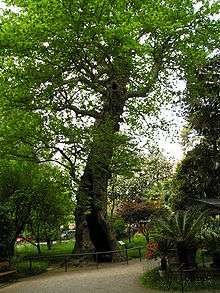Ombra mai fu
"Ombra mai fu", also known as "Largo from Xerxes", is the opening aria from the 1738 opera Serse by George Frideric Handel.
Context
The opera was a commercial failure, lasting only five performances in London after its premiere. In the 19th century, however, the aria was rediscovered and became one of Handel's best-known pieces. Handel adapted the aria from the setting by Giovanni Bononcini, who, in turn, adapted it from the setting by Francesco Cavalli. All three composers had produced settings of the same opera libretto by Nicolò Minato.
Music
Originally composed to be sung by a soprano castrato (and sung in modern performances of Serse by a countertenor, contralto or a mezzo-soprano), it has been arranged for other voice types and instruments, including solo organ, solo piano, violin and piano, and string ensembles, often under the title "Largo from Xerxes", although the original tempo is marked larghetto.
In the opera, the aria is preceded by a short recitativo accompagnato of 9 bars, setting the scene ("Frondi tenere e belle"). The aria itself is also short; it consists of 52 bars and typically lasts three to four minutes.
The instrumentation is for a string section: first and second violins, viola, and basses. The key signature is F major, the time signature is 3/4 time. The vocal range covers C4 to F5 with a tessitura from F4 to F5.
Libretto

The title translates from the Italian as "Never was a shade". It is sung by the main character, Xerxes I of Persia, admiring the shade of a plane tree.
Frondi tenere e belle
del mio platano amato
per voi risplenda il fato.
Tuoni, lampi, e procelle
non v'oltraggino mai la cara pace,
né giunga a profanarvi austro rapace.
Ombra mai fu
di vegetabile,
cara ed amabile,
soave più.
Tender and beautiful fronds
of my beloved plane tree,
let Fate smile upon you.
May thunder, lightning, and storms
never disturb your dear peace,
nor may you by blowing winds be profaned.
Never was a shade
of any plant
dearer and more lovely,
or more sweet.
Cultural references
On 24 December 1906, Reginald Fessenden, a Canadian inventor and radio pioneer, broadcast the first AM radio program, which started with a phonograph record of "Ombra mai fu" followed by his playing "O Holy Night" on the violin and singing the final verse. The aria therefore was the first piece of music to be broadcast on radio.[1][2]
An 1980s electronic mix instrumental version of the aria can be heard in the cherry blossom viewing scene and forms a central part of Kon Ichikawa's 1983 film The Makioka Sisters'.[3]
References
- Collins, Ace (4 May 2010). Stories Behind the Best-loved Songs of Christmas. Grand Rapids, Michigan: Zondervan. pp. 137–138. ISBN 978-0310873877.
- Fessenden, Helen (1940). Builder of Tomorrows. New York: Coward-McCann. pp. 153–154. Retrieved 25 January 2020.
- "Opera Meets Film: How Kon Ichikawa's Use of 'Ombra mai fu' Explores Theme in The Makioka Sisters" by David Salazar, Operawire, 18 June 2020
External links
- Free scores of "Ombra mai fu" in the Choral Public Domain Library (ChoralWiki)
- "Ombra mai fu": Scores at the International Music Score Library Project (IMSLP)
- "Ombra mai fu" at The Aria Database